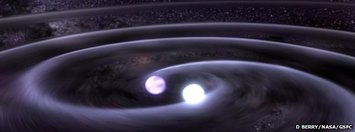
The particular binary system, entitled rather unimaginatively J0651, consists of two 'white dwarf' stars orbiting at a distance from each other of about 1/3 the Earth-moon distance (approximately 125,000 km). They are both quite massive objects, one star being 25% the mass of the Sun and the other about 55% . But the amazing thing is that they complete an orbit around each other in only 12 minutes and 45 seconds. A simple sum tells us that they are traveling at about 520 km/sec - not bad! However, the evidence supporting the emission of gravitational radiation comes from looking at how the orbit period (time for the stars to go round each other) is changing. The emission of the radiation causes the system to lose energy, resulting in the change in orbit period. In the 13 months since the object was discovered the orbit period has changed by less than 1/1000 th of a second, but over time this change will lead to the two stars coming together in about 900,000 years time. The study of this extreme object provides another test for Einstein's theory, which it passes very neatly, within the tolerances of the current observations. See http://arxiv.org/abs/1107.2389/ for the abstract of the paper.
The reason I found this particularly interesting is that I did my PhD thesis way back in the dark ages (1975) on the 'cosmological implications of gravitational radiation' ... and we are still finding difficulty directly observing this particular prediction of Einstein's theory of gravity. This will have to await the launch of very sophisticated gravitational wave detectors into space.
 RSS Feed
RSS Feed
